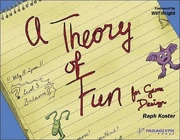
By Raph Koster, 2005
Chapter 1: Why Write This Book?
Koster sets out the context and mission of his work in this chapter. Kids, he opens with, use games as learning tools even before learning language, and see patterns in games like tic-tac-toe even if they cannot understand them in the same way adult designers might. This ability seems to fall off with age -- Koster himself admits to having experienced the sad phenomenon of boredom from games that are too easy and games that are too difficult alike (10). This, combined with the growing cultural force of games and play's relation to work, is why Koster decided to "tackle the questions of what games are, and what fun is, and why games matter," the three major themes of his book (10).
Chapter 2: How the Brain Works
This chapter begins with a discussion of possible definitions of a game, citing minds such as Johan Huizinga, Jesper Juul, and Chris Crawford among others. Koster's personal definition is connected to how the brain works: "Games are just exceptionally tasty patterns to eat up" (14). Koster follows this up with a primer on how the brain works, focusing on the phenomenon he describes as "chunking," the division of large sets of information into usable groups. This tendency helps us cut through the "noise" of everyday life and get usually reliable information from it.
As the mind gets more and more accustomed to using specific chunks of information, levels of understanding increase. The highest level of understanding is something Koster calls "grokking ," a level of familiarity akin to muscle memory. To Koster, the ultimate goal of the brain is turning certain actions into routines in order to allow more time for conscious thought (32). Mastering a game may be an example of this phenomenon.
Chapter 3: What Games Are
In this chapter, Koster explores the possible meaning of "game" further, linking it to the way the brain works as described in the previous chapter. To Koster, games are puzzles to be solved and provide lessons to be learned (or grokked.) This is where the notion of "fun" comes from: "Fun from games arises out of mastery," Koster writes, "It is the act of solving puzzles that makes games fun. In other words, with games, learning is the drug" (40).
Following this logic, the best games are those that have enough variables to keep the new data flowing in order for the brain to keep learning for as long as possible before the player stops playing. Tic-tac-toe, for example, with its limited amount of permutations, is easy to master, and so boredom sets in after a relatively low number of playthroughs. On the other hand, a complicated contemporary game has more variables, and thus provides more challenges and more fun for a longer period.
Chapter 4: What Games Teach Us
Having established a working definition for games, Koster continues to flesh out the properties of games mainly by explaining what they do. He goes on to briefly touch on many of these functions: games help us practice calculating odds, teach spatial relationships, and encourage conceptual exploration. All of these themes seem to come down to teaching skills that were useful in humanity’s distant past, when we were all “hierarchical and strongly tribal primates” and so almost always have something to do with power, survival, and maintaining hierarchy (52, 69). This is a problem to Koster, who holds that games should be evolving to teach players skills more relevant to (and acceptable in) the modern world, like networking or teamwork (66). After this, Koster goes into a discussion on game topology, the basic mechanics of gameplay that are rehashed in genres like the platformer. Because of this, Koster says, the evolution of games is much slower than it could be, and the same old paradigms are repeated until a new innovation arises. The chapter ends with a review of the characteristics of games (76) and an application of his concepts of topology and evolution through the history of the 2-D shooter (or “shmup”) genre (78).